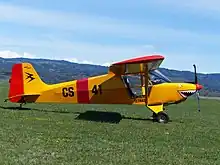Humbert Tétras
The Humbert Tétras (English: Grouse) is a French two seat ultralight with a single engine and high wing. Available as a kit or complete aircraft, it has been in production since 1994 by Humbert Aviation of Ramonchamp.
| Tétras | |
|---|---|
.jpg.webp) | |
| A Humbert Tétras Mali Air Force | |
| Role | Two seat ultralight or kit build |
| National origin | France |
| Manufacturer | Humbert Aviation |
| Designer | Humbert Aviation |
| First flight | c.1992 |
| Introduction | 1994 |
| Status | In production |
| Produced | 1992-present |
| Number built | c.150 by 2010 |
Design and development
The Tétras was first seen in public in 1992 at the RSA Rally at Moulins and marketing began in 1994. It is a conventionally laid out single engine, tractor configuration light aircraft with a high wing, side-by-side seating for two and a fixed undercarriage.[1]
Its straight non tapered wing is a composite structure, with an aluminium frame, Styrofoam filling and fabric covering.[1][2] The ailerons and three-position flaps are made of aluminium. The wings are braced on each side with a single lift strut to a lower fuselage longeron. The tailplane, mounted at mid-fuselage height, is also strut braced. The fuselage of the Tétras is a steel structure covered with Dacron. Variants with both tricycle and conventional undercarriages, all fixed, have been built. The former arrangement has spring cantilever main legs, the latter has the mainwheels mounted on faired V-strut legs and bungee sprung half axles fixed to a compression frame. Both undercarriage variants have hydraulic brakes. Skis may also be fitted.[1]
The Tétras has been fitted with a variety of engines; originally the 54 kW (72 hp) Humbert-Volkswagen HW 2000 was used. More recently two flat fours from the Rotax range, the 60 kW (80 hp) 912 UL or the 74 kW (98 hp) 912 ULS, have become standard choices.[1]
Operational history
About 150 Tétras appeared on the French ultralight register in October 2010. The French Centre d'Essais en Vol have tested the Tétras for military use, and Niger has used it for insecticide spraying.[1]
Variants
Data from Jane's All the World's Aircraft 2011/12[1]
- Tétras A
- Initial version
 Tetras on parked on display
Tetras on parked on display - Tétras B
- Standard version, introduced 1998. Early examples had the HW 2000 engine but the 80 hp (60 kW) Rotax 912UL, or optionally the 100 hp (75 kW) Rotax 912ULS engine, is currently (2015) fitted. Currently available.[3][4]
- Tétras BS
- 912 ULS engine. Currently available.
- Tétras CS
- Introduced 2007 with a 600 mm (23.6 in) shorter span wing. 912 ULS engine. Marketed 2008-9.
- Tétras CT
- Tricycle undercarriage version of CS, with 512 UL engine. Marketed 2008-9.
- Tétras CTS
- As CT with 512 ULS engine. Marketed 2008-9.
Operators
- Military of Burkina Faso – Three aircraft were donated by France in October 2012.[5]
- Cameroon Air Force - Eight aircraft (reg. TJX-CS, TJX-CT, TJX-CU, TJX-CV, TJX-CZ, TJX-DA, TJX-DB, TJX-DC) [6]
- Military of Guinea – At least five aircraft were donated by France, one crashed on 5 October 2016.[7]
- Malagasy Air Force – Three aircraft (5R-MNQ, 5R-MNR, 5R-MNT) [8]
- Malian Air Force – Seven aircraft as of 2011.[9]
- Niger Air Force – Eight Tétras 912SCMs delivered from France around 2008. One crashed in 2010 and another the following year. As of 2018, three aircraft were in service, with the remaining three stored.[10]
Specifications (Tétras B)
Data from Jane's All the World's Aircraft 2011/12[1]
General characteristics
- Capacity: 2
- Length: 6.50 m (21 ft 4 in)
- Wingspan: 10.10 m (33 ft 2 in)
- Height: 2.06 m (6 ft 9 in)
- Wing area: 15.70 m2 (169.0 sq ft)
- Airfoil: NACA 23012
- Empty weight: 256 kg (564 lb)
- Max takeoff weight: 450 kg (992 lb) ; where permitted, 495 kg (1,091 lb)
- Fuel capacity: 60 L (15.9 USgal, 13.2 Impgal) standard. Can be increased to 85 L (22.5 USgal, 18.7 Impgal) outside France.
- Powerplant: 1 × Rotax 912 UL flat four, 59.6 kW (79.9 hp)
- Propellers: 2-bladed DUC FC composite, 1.75 m (5 ft 9 in) diameter
Performance
- Maximum speed: 194 km/h (121 mph, 105 kn)
- Cruise speed: 180 km/h (110 mph, 97 kn) at 75% power and 3,048 m (10,000 ft)
- Stall speed: 55 km/h (34 mph, 30 kn) flaps down
- Range: 700 km (430 mi, 380 nmi) with standard fuel capacity
- g limits: +4/-2
- Rate of climb: 7.5 m/s (1,480 ft/min) maximum at sea level
References
Citations
- Jackson, Paul (2011). Jane's All the World's Aircraft 2011-12. Redhill, UK: IHS Jane's. p. 205. ISBN 978-0-7106-2955-5.
- Simpson, Rod (2001). Airlife's World Aircraft. Shrewsbury: Airlife Publishing Ltd. pp. 285–6. ISBN 1-84037-115-3.
- Bayerl, Robby; Martin Berkemeier; et al: World Directory of Leisure Aviation 2011-12, page 59. WDLA UK, Lancaster UK, 2011. ISSN 1368-485X
- Tacke, Willi; Marino Boric; et al: World Directory of Light Aviation 2015-16, page 61. Flying Pages Europe SARL, 2015. ISSN 1368-485X
- Martin, Guy (January 2013). "Burkina Faso Receives Tétras". Air International. Vol. 84, no. 1. p. 15. ISSN 0306-5634.
- "All-Time Aircraft Used List Cameroon Air Force – Aeroflight".
- Lagneau, Laurent (10 October 2016). "Un officier français s'est tué aux commandes d'un avion léger en Guinée". Zone Militare (in French). Retrieved 2 March 2017.
- Cooper et al. 2011, p. 226
- Cooper et al. 2011, pp. 226–227
- Delalande, Arnaud (15 March 2018). "Niger's desert warriors". Key Aero.
Bibliography
- Cooper, Tom; Weinert, Peter; Hinz, Fabian; Lepko, Mark (2011). African MiGs, Volume 2: Madagascar to Zimbabwe. Houston: Harpia Publishing. ISBN 978-0-9825539-8-5.